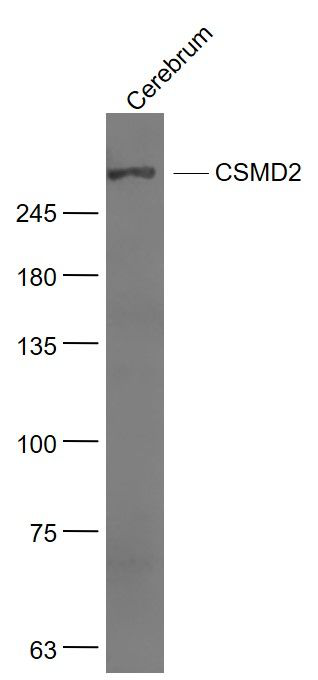产品货号 : mlR12937
英文名称 : CTBS
中文名称 : CTBS蛋白抗体
别 名 : Chitobiase di N acetyl; CTB; Di N acetylchitobiase; OTTHUMP00000011570; DIAC_HUMAN.
研究领域 : 细胞生物 细胞类型标志物
抗体来源 : Rabbit
克隆类型 : Polyclonal
交叉反应 : Human, Mouse, Rat,
产品应用 : WB=1:500-2000 ELISA=1:500-1000 IHC-P=1:400-800 IHC-F=1:400-800 ICC=1:100-500 IF=1:100-500 (石蜡切片需做抗原修复)
not yet tested in other applications.
optimal dilutions/concentrations should be determined by the end user.
分 子 量 : 40kDa
细胞定位 : 细胞浆
性 状 : Lyophilized or Liquid
浓 度 : 1mg/ml
免 疫 原 : KLH conjugated synthetic peptide derived from human CTBS:1-100/385
亚 型 : IgG
纯化方法 : affinity purified by Protein A
储 存 液 : 0.01M TBS(pH7.4) with 1% BSA, 0.03% Proclin300 and 50% Glycerol.
保存条件 : Store at -20 °C for one year. Avoid repeated freeze/thaw cycles. The lyophilized antibody is stable at room temperature for at least one month and for greater than a year when kept at -20°C. When reconstituted in sterile pH 7.4 0.01M PBS or diluent of antibody the antibody is stable for at least two weeks at 2-4 °C.
PubMed : PubMed
产品介绍 : CTBS is an evolutionarily conserved member of the glycosyl hydrolase 18 family of proteins. Localizing to the lysosome, CTBS plays a role in the degradation of asparagine-linked (Asn-linked) glycoproteins. Glycoproteins are translocated to lysosomes via endocytosis or autophagy where they are broken down by proteases and glycosidases. The catabolism of glycoproteins is an important step in the regular turnover of cellular contents and in maintaining the homeostasis of glycosylation. CTBS functions as a glycosidase that cleaves the reducing end GlcNAc from the core chitobiase unit of oligosaccharides. Before this reaction can occur, AGA (the lysosomal glycosylasparaginase) must first remove the Asn from the Asn-linked glycoprotein to expose the reducing end GlcNAc, thereby allowing CTBS to access the exposed moiety.
Function:
Involved in the degradation of asparagine-linked glycoproteins. Hydrolyze of N-acetyl-beta-D-glucosamine (1-4)N-acetylglucosamine chitobiose core from the reducing end of the bond, it requires prior cleavage by glycosylasparaginase.
Subcellular Location:
Lysosome.
Similarity:
Belongs to the glycosyl hydrolase 18 family.
SWISS:
Q01459
Gene ID:
1486
Important Note:
This product as supplied is intended for research use only, not for use in human, therapeutic or diagnostic applications.
产品图片












